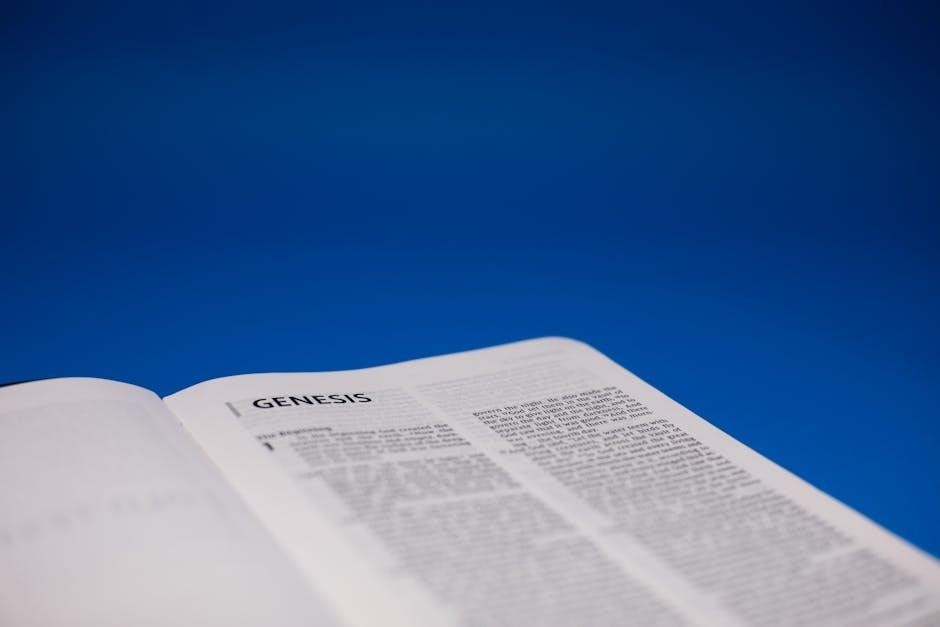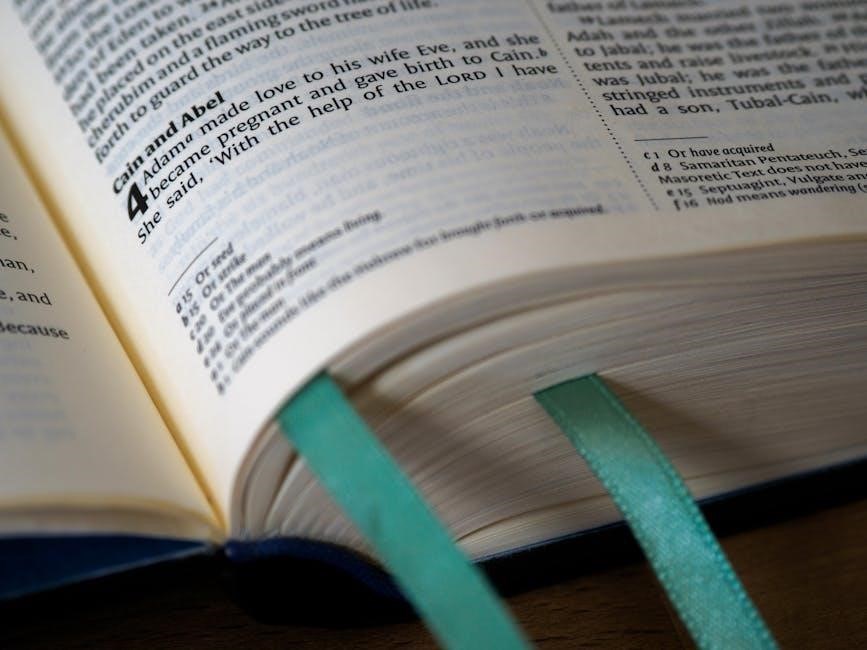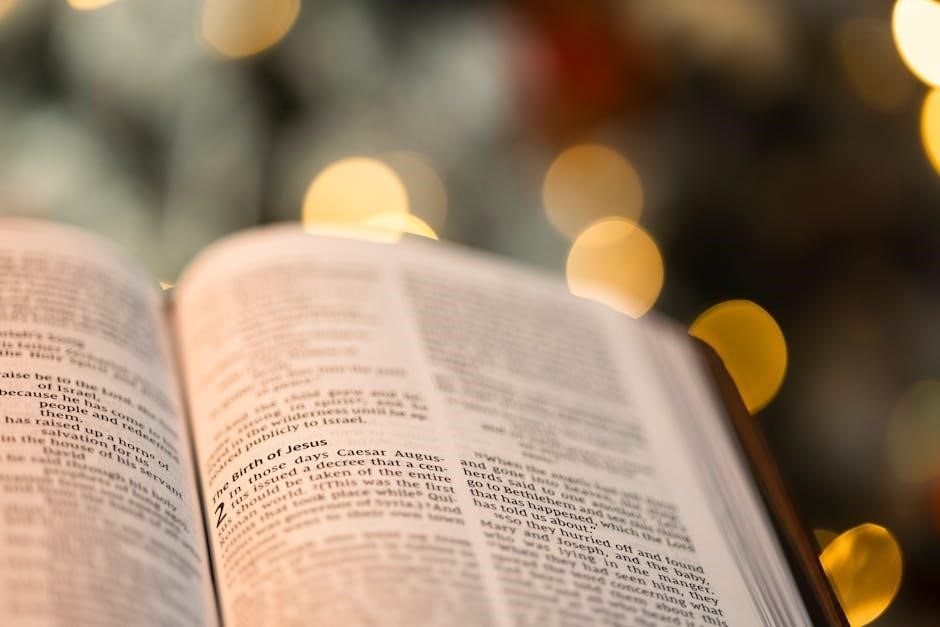
the book of genesis pdf
The Book of Genesis, the first book of the Bible, provides a foundational narrative of creation, humanity, and the ancestry of the Israelites. Written by Moses, it explores themes of divine sovereignty, human frailty, and redemption. The creation story, early humanity’s fall, and the flood narrative are central, shaping theological and cultural understanding. Available as a free PDF download, Genesis offers insights into God’s covenant with Abraham and the origins of civilization, making it a vital text for religious and historical studies.

Background Information
The Book of Genesis, the first book of the Bible, serves as the foundational narrative for both Jewish and Christian traditions. Attributed to Moses, it is part of the Pentateuch and sets the stage for understanding God’s relationship with humanity. The book spans from creation to the early history of the Israelites, providing a theological and historical framework. Its name, derived from the Greek word for “origin,” reflects its focus on beginnings. Genesis is divided into two main sections: the primeval history (Chapters 1–11) and the patriarchal history (Chapters 12–50). It explores themes of creation, sin, and redemption, establishing key motifs that resonate throughout the Bible. Available as a free PDF download, Genesis remains a vital resource for religious, historical, and cultural study, offering insights into the origins of the world and humanity’s divine connection.
Importance in Religious Texts
The Book of Genesis holds profound significance in religious texts, particularly within Judaism, Christianity, and Islam. It is the foundational book of the Hebrew Bible and the Christian Old Testament, detailing the creation of the world and humanity’s relationship with God. Genesis establishes key theological concepts such as monotheism, covenant, and divine sovereignty. The narratives of Adam and Eve, Noah’s Ark, and the Tower of Babel provide moral and spiritual lessons that shape religious beliefs. Its influence extends beyond scripture, impacting art, literature, and philosophy. As a free PDF download, Genesis remains a central text for religious study, offering insights into the nature of God and humanity’s role in the divine plan. Its teachings continue to inspire and guide followers of Abrahamic faiths, making it a cornerstone of religious understanding and reflection.

Content Overview of the Book of Genesis
The Book of Genesis is a foundational narrative detailing creation, early humanity, the fall, and the ancestry of the Israelites. It explores key events like the flood and the Tower of Babel, shaping theological and cultural understanding.
The Creation Story
The creation story in Genesis describes how God brought order to chaos, forming the world over six days. On the first day, light was separated from darkness, named Day and Night. The second day saw the creation of the sky, dividing water from land. Vegetation emerged on the third day, followed by the sun, moon, and stars on the fourth. The fifth day brought sea creatures and birds, while the sixth day introduced land animals and humanity. God created man and woman in His image, granting them dominion over Creation. The seventh day was a day of rest, sanctified by God. This narrative underscores God’s purposeful design, emphasizing humanity’s unique role and the intrinsic value of all creation. The story is foundational to theological understanding and is widely studied, with the Book of Genesis PDF offering accessible reading for deeper exploration.

Early Humanity and the Fall
The narrative of early humanity in Genesis focuses on Adam and Eve, the first humans created by God in His image. Placed in the Garden of Eden, they were given dominion over creation and a single command: not to eat from the tree of the knowledge of good and evil. The serpent, symbolizing temptation, deceived Eve, who shared the forbidden fruit with Adam. This act of disobedience led to the Fall, introducing sin and separation from God. As a consequence, humanity faced suffering, death, and expulsion from Eden. The story explores themes of free will, moral responsibility, and the origin of evil. It also hints at redemption through God’s promise of a future savior. This foundational narrative shapes theological understanding of human nature and the divine plan, as detailed in the Book of Genesis PDF.
The Ancestry of the Israelites
The Book of Genesis traces the ancestry of the Israelites, beginning with the creation of humanity and narrowing to the patriarchs Abraham, Isaac, and Jacob. God establishes a covenant with Abraham, promising to make him the father of a great nation. This covenant is central to the Israelites’ identity as God’s chosen people. The narrative follows Abraham’s descendants, including Ishmael and Isaac, with divine favor resting on Isaac. Jacob, whose name is later changed to Israel, becomes the progenitor of the twelve tribes of Israel. The stories of Joseph and his brothers further solidify the family’s role in shaping the nation’s history. These accounts provide a theological framework for understanding God’s sovereignty and the concept of a chosen people. The Book of Genesis PDF offers detailed insights into these narratives, highlighting their significance in Jewish, Christian, and Islamic traditions. The ancestry of the Israelites remains a cornerstone of biblical history and identity.
Major Events and Narratives
The Book of Genesis contains some of the most iconic and influential stories in religious and cultural history. The creation story, spanning six days, highlights God’s power in bringing order to chaos. The fall of Adam and Eve introduces the concept of sin, while the flood narrative underscores divine judgment and redemption through Noah’s ark. The Tower of Babel explains the origin of diverse languages, illustrating human ambition and divine intervention. These events are central to understanding the theological and moral framework of the text. The Book of Genesis PDF provides a detailed account of these narratives, offering insights into themes such as obedience, faith, and God’s relationship with humanity. These stories have shaped religious beliefs, artistic interpretations, and cultural traditions, making Genesis a cornerstone of biblical literature.

Structure and Themes
The Book of Genesis is structured around key themes such as creation, covenant, and redemption. It explores God’s relationship with humanity, emphasizing faith, obedience, and divine sovereignty. The narrative unfolds through pivotal events, including the seven days of creation and the early stories of humanity, laying the theological groundwork for the rest of the Bible. Available as a Book of Genesis PDF, the text examines the nature of sin, judgment, and redemption, offering profound insights into the human condition and God’s plan for His people.
The Seven Days of Creation

The seven days of creation, as described in Genesis, form the cornerstone of the biblical account of the world’s origin. God, depicted as an omnipotent and purposeful Creator, systematically brings order to chaos; On the first day, light is separated from darkness. The second day introduces the firmament, dividing the waters. Land, vegetation, and fruit-bearing plants emerge on the third day. The fourth day sees the creation of the sun, moon, and stars to govern time. The fifth day brings forth sea creatures and birds, while the sixth day introduces land animals and humanity. God creates humans in His image, granting them dominion over all creation. The seventh day is set apart as a day of rest, sanctified by God. This narrative emphasizes God’s sovereignty, purpose, and the intrinsic value of creation. The account is both a theological and cosmological explanation of the world’s beginnings, available for deeper exploration in the Book of Genesis PDF.
The Story of Adam and Eve
The story of Adam and Eve, detailed in the early chapters of Genesis, recounts the creation of humanity and the origins of sin. Adam, formed from the earth, and Eve, created from Adam’s rib, were placed in the Garden of Eden, a paradise of abundance and beauty. God commanded them not to eat from the Tree of Knowledge of Good and Evil, symbolizing humanity’s first moral choice. The serpent, representing temptation, deceived Eve, who then shared the forbidden fruit with Adam. This act of disobedience led to their expulsion from Eden, introducing suffering and death into the world. The narrative highlights humanity’s free will, the nature of sin, and the beginning of the redemptive plan. The story of Adam and Eve serves as a foundational theological framework, exploring themes of innocence, temptation, and divine grace, all of which are central to the biblical worldview and available for study in the Book of Genesis PDF.
The Flood Narrative
The flood narrative in Genesis recounts God’s judgment on humanity due to widespread wickedness. Seeing the earth filled with violence, God chose Noah, a righteous man, to build an ark to save himself, his family, and two of every kind of animal. The flood, which lasted 40 days and 40 nights, destroyed all life except those on the ark. After the waters receded, Noah released birds to determine if the earth was dry. God then established a covenant with Noah, promising never again to destroy the earth with a flood, signified by the rainbow. This story emphasizes divine justice, mercy, and the beginning of a new creation, making it a pivotal event in the Book of Genesis, highlighting themes of redemption and divine grace.
The Tower of Babel
The Tower of Babel narrative in Genesis 11 describes humanity’s unified effort to construct a towering monument to their own glory. After the flood, humanity, speaking a single language, sought to build a tower that would reach the heavens, symbolizing their pride and ambition. God, observing their arrogance, confused their language, causing widespread confusion and scattering the people across the earth. This event explains the origin of diverse languages and the dispersion of nations. The story underscores themes of human pride, divine intervention, and the limitations placed on human endeavors. It also highlights God’s desire for humanity to spread and fill the earth, as initially commanded in the creation story. The Tower of Babel serves as a reminder of the consequences of collective arrogance and the divine will to maintain humility and diversity among nations.

Key Figures in Genesis
Key figures in Genesis include Adam, Eve, Noah, Abraham, Isaac, Ishmael, Jacob, Esau, and Joseph. These individuals play pivotal roles in shaping the narrative of creation, covenant, and redemption, reflecting God’s divine plan and human response.
Adam and Eve
Adam and Eve, the first humans created by God, are central figures in the Book of Genesis. According to Genesis 1:26-27, God created them in His image, granting them dominion over the earth. They were placed in the Garden of Eden, a paradise of abundance and beauty, with the sole command not to eat from the Tree of Knowledge of Good and Evil. The serpent’s temptation led Eve to eat the forbidden fruit, and Adam followed, resulting in the fall of humanity. This act of disobedience introduced sin into the world, leading to their expulsion from Eden. Despite their failure, Adam and Eve became the progenitors of humanity, symbolizing both the potential for sin and the hope of redemption. Their story is a cornerstone of theological understanding, exploring themes of free will, morality, and divine grace. The narrative of Adam and Eve remains a pivotal moment in human history.
Noah and the Ark
Noah and the Ark are central to the flood narrative in Genesis, symbolizing divine judgment and salvation. According to Genesis 6-9, God, seeing the earth filled with wickedness, chose Noah, a righteous man, to build an ark to save his family and two of every kind of animal. The ark, a massive vessel, was constructed according to God’s instructions to withstand the impending flood. When the rains came, the flood devastated the earth, destroying all life except those aboard the ark. After 40 days, the waters receded, and Noah released a dove, raven, and finally a rainbow, signaling God’s covenant never again to destroy the earth with a flood. Noah’s obedience and faith in God’s plan highlight themes of redemption and renewal. The story of Noah and the Ark remains a powerful symbol of salvation and divine mercy. Its significance is profound, shaping theological and cultural narratives globally.
Abraham and His Covenant
Abraham is a central figure in the Book of Genesis, known for his unwavering faith and the covenant he established with God. According to Genesis 12-17, God promised Abraham that he would be the father of a great nation, with numerous descendants and a land of inheritance. This covenant, sealed through circumcision, marked Abraham as a chosen servant of God. The story of Abraham and his covenant is detailed in Genesis PDF downloads, highlighting his obedience and trust in divine promises; The covenant signifies God’s plan for redemption and serves as a foundational theme in biblical theology. Abraham’s journey, including his willingness to sacrifice Isaac, underscores his devotion and the depth of his relationship with God. The narrative of Abraham remains a cornerstone of religious and cultural identity, emphasizing faith, obedience, and divine providence. His story is a testament to God’s faithfulness and the enduring nature of His promises.
Isaac and Ishmael
Isaac and Ishmael are two significant figures in the Book of Genesis, representing the complex dynamics of Abraham’s family. Isaac, the son of Abraham and Sarah, is born miraculously in their old age, fulfilling God’s promise of an heir. Ishmael, the son of Abraham and Hagar, Sarah’s servant, is born earlier but later cast out due to Sarah’s jealousy. Despite this, God promises Hagar that Ishmael will also become a great nation. The tension between the two brothers reflects the broader themes of divine promise, human conflict, and the complexities of family relationships. Both Isaac and Ishmael play crucial roles in the narrative, with Isaac continuing Abraham’s covenantal lineage and Ishmael symbolizing God’s mercy and provision. Their stories, detailed in Genesis PDFs, highlight the interplay of faith, identity, and divine sovereignty. Both figures are buried in the same place, underscoring their shared heritage despite their divergent paths.
Jacob and Esau
Jacob and Esau, twin sons of Isaac and Rebekah, are central figures in the Book of Genesis, embodying themes of divine election, sibling rivalry, and personal transformation. Their story begins with Esau, the firstborn, selling his birthright to Jacob for a bowl of lentil stew, a decision that underscores his lack of regard for his inheritance. This act sets the stage for a lifelong struggle between the two brothers, with Jacob deceitfully obtaining Isaac’s blessing meant for Esau. The tension escalates when Esau plots revenge, leading Jacob to flee to Haran, where he encounters Laban and experiences further trials. Despite the conflict, their relationship evolves, culminating in a poignant reunion where Esau forgives Jacob. Their narrative, detailed in Genesis PDFs, explores themes of identity, divine favor, and reconciliation, offering profound insights into human nature and the unfolding of God’s plan. Their stories remain pivotal in understanding the ancestral lineage of the Israelites.
Joseph and His Brothers
Joseph, the favored son of Jacob, is a central figure in the Book of Genesis, with his story spanning chapters 37-50. His narrative begins with Jacob giving him a coat of many colors, symbolizing his preference, which provokes jealousy among his brothers. This resentment escalates when Joseph shares dreams indicating his future dominance, leading his brothers to sell him into slavery in Egypt. Despite his hardships, Joseph rises to prominence through his ability to interpret dreams, eventually becoming a trusted advisor to Pharaoh. When a famine strikes Canaan, Joseph’s brothers come to Egypt for food, unaware they are seeking help from the brother they wronged. The story culminates in Joseph’s emotional revelation and forgiveness of his brothers, showcasing themes of divine providence, forgiveness, and reconciliation. The detailed account of Joseph’s life in Genesis PDFs highlights his journey from betrayal to blessings, illustrating God’s sovereignty in human affairs.

Theological Themes
The Book of Genesis explores theological themes such as the nature of God, covenant, sin, and redemption. It highlights divine sovereignty and human responsibility, shaping Christian and Jewish doctrines.
The Nature of God
The Book of Genesis profoundly reveals the nature of God as omnipotent, benevolent, and just. The creation narrative illustrates God’s power and wisdom, as He brings order to chaos. His speech, “Let there be light,” demonstrates His authority and creative will. The story of the flood highlights His judgment on sin while also showing mercy through Noah’s salvation. Genesis also portrays God as relational, walking with Adam in Eden and establishing a covenant with Abraham. His holiness and sovereignty are evident in His separation of light from darkness and His promise to Abraham. These narratives collectively depict God as both transcendent and immanent, actively involved in creation and human history. The book underscores God’s faithfulness and grace, laying the theological foundation for understanding His character throughout the Bible. The nature of God in Genesis is central to its message, shaping theological and doctrinal perspectives for centuries.
The Concept of Covenant
The concept of covenant is a central theological theme in the Book of Genesis, representing a sacred agreement between God and humanity. The first covenant is implied in God’s promise to never again destroy the earth with a flood, symbolized by the rainbow. The most significant covenant, however, is established with Abraham, where God promises to make him the father of a great nation and guarantees the land of Canaan to his descendants. This covenant is sealed through circumcision, marking the Israelites as God’s chosen people. The Abrahamic covenant underscores God’s faithfulness, grace, and redemptive plan. It establishes a divine-human relationship based on trust and obedience, shaping the identity of the Israelites and serving as the foundation for later theological developments in the Bible. The concept of covenant in Genesis highlights God’s commitment to His people and sets the stage for the broader narrative of redemption in Scripture.

Sin and Redemption
The Book of Genesis introduces the concept of sin and redemption through key narratives. The story of Adam and Eve’s disobedience in the Garden of Eden marks the introduction of sin, leading to separation from God and the entrance of suffering into the world. The subsequent narrative of Cain and Abel further explores the consequences of sin, as Cain’s jealousy results in violence. However, Genesis also offers glimpses of redemption, such as God’s mercy in sparing Cain’s life and His covenant with Noah after the flood, symbolizing a fresh start. The story of Abraham and his descendants highlights God’s redemptive plan, as He promises to bless all nations through Abraham’s family. These themes of sin and redemption lay the theological groundwork for understanding God’s grace and humanity’s need for divine intervention, central to the Bible’s overarching narrative.

Historical and Cultural Significance
The Book of Genesis holds profound historical and cultural importance, shaping religious and philosophical thought. It provides archaeological insights into ancient civilizations and influences Western civilization’s moral and ethical frameworks. Widely studied and downloaded as a PDF, Genesis remains a cornerstone of human history and divine revelation.
Archaeological Evidence
Archaeological discoveries have shed light on the historical context of the Book of Genesis, providing insights into ancient civilizations and their cultures. Excavations in Mesopotamia, for instance, have uncovered evidence of early cities and flood legends, paralleling the Genesis account of Noah’s Ark. Similarly, the Indus Valley Civilization and Egyptian records reflect cultural practices and societal structures described in Genesis. While direct archaeological proof of specific biblical events remains limited, findings such as the Ebla Tablets and the Nuzi Tablets corroborate the historical plausibility of patriarchal narratives. These discoveries bridge the gap between biblical accounts and ancient history, offering a tangible connection to the world described in Genesis. Such evidence enhances the study of the text, available as a free PDF, by grounding its stories in a verifiable historical framework.
Influence on Western Civilization
The Book of Genesis has profoundly shaped Western civilization, influencing art, literature, philosophy, and ethics. Its narratives, such as the creation story and the fall of humanity, have inspired countless works of art, from Michelangelo’s “Creation of Adam” to literary masterpieces. The concept of monotheism, central to Genesis, has molded religious and philosophical thought, underpinning Judeo-Christian values. The idea of a covenant with God has influenced political and social structures, while the story of Noah’s Ark has become a cultural metaphor for salvation. Additionally, Genesis’s themes of human dignity and moral responsibility have informed ethical frameworks. Its impact extends to science, with interpretations of creation sparking debates on origins. Available as a free PDF, Genesis remains a foundational text, shaping the intellectual and cultural heritage of the West, ensuring its relevance across centuries. Its enduring influence underscores its role as a cornerstone of Western thought and identity.